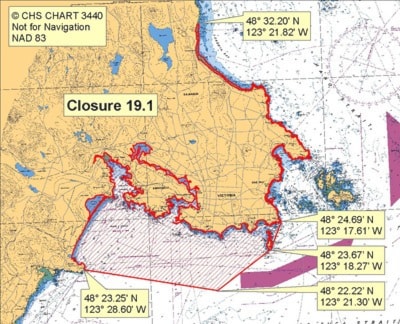Activists, scientists still disagree about safety of Victoria’s sewage
Shellfish in the south Island may not get a say in how Victoria treats its sewage, but the bi-valve creatures could be speaking volumes.
A shellfish contamination alert has permanently closed an area from Albert Head in Metchosin around the southern tip of the Island to Cordova Bay, the region bordering Victoria’s two sewage outfalls. The sanitary closure isn’t news — the Department of Fisheries and Oceans Canada (DFO) has preserved this year-round harvesting ban since 1990, just years after the outfalls were installed — but the impact on mollusks and crustaceans in the region has some considering the messages.
“The majority of contamination we see is in the area of the outfalls,” says Elysha Gordon, shellfish biologist with the DFO and resource management coordinator for the Canadian Shellfish Sanitization Program. “With most fish and animals, the animal eats something, then excretes it. With bi-valves, and sometimes crabs, the substances it eats accumulate and stay in its body.”
The Macaulay and Clover Point outfalls have been in use since the 1970s, with wastewater passing through fine, six-millimetre screens that remove solid objects larger than a thumbtack. The remaining wastewater is jetted out through two multi-port outfalls located 60 metres below the surface, where it mixes with seawater and is dispersed by tidal currents in the Juan de Fuca Strait. Yet with time crunching down on the Capital Regional District to assert a new sewage plan, activists on both sides of the issue are stoking the debate.
“Diluting our waste into the sea is totally irresponsible, and we are using an outdated view from the ’90s,” says Victoria City Councillor Ben Isitt. “I’m convinced treatment is the way to go. The age of easy money to build infrastructure is behind us — we’ll never have as much money as we do now, so the only answer is to stop pollution now.”
But while an impact seems clear, Isitt agrees that only time will tell the environmental and financial reactions caused from the proposed secondary sewage treatment plant — a proposal that will mean redistributing more concentrated waste either to Hartland Landfill or other yet unknown means of disposal. Some residents have taken a firm stance against leaping into salty water before all the facts are clear.
“Shellfish are banned for contamination near most densely populated areas due to the pollution of storm drain run-off, so I think it is very unlikely that, even if the outfalls had more treatment, we would see the ban lift,” says Dr. Shaun Peck, former medical officer of health to the CRD and a board member of the Association for Responsible and Environmentally Sustainable Sewage Treatment (ARESST). “It is very difficult to see the clear benefit that a treatment plant would give Victoria … what we’re dealing with here is people’s belief systems versus the evidence.”
So far, that evidence has shown surface water sampling around the outfalls to record safe fecal coliform levels that have remained well below B.C.’s guidelines to protect swimmers — although some higher levels (termed “plumes”) have been recorded in the winter months near the end of the outfalls.
In 2008, a CRD-lead study found that “minor effects” resulted from the discharge area (approximately the size of a football field) around each outfall. While the majority of sediment substances were found to be at levels similar to previous years, a few substances, like metals, showed an increase in concentration close to the outfalls. Even in that report four years ago, the CRD predicted there could be potential effects on seafloor organisms within these areas, though they also discovered an increase in organisms closer to the outfalls, likely due to “an abundant food source” from the discharge. These “outfall communities” also showed a different composition of organisms, although the CRD reported that their function and health were similar to communities further away — at Clover Point, mussels near the outfall were larger than those further away. Measurements of age and reproductive status, as well as tissue chemistry showed “no harmful effects” from the outfall, though the shellfish-harvesting ban was in effect then.
Gordon says, indeed, there are “no guarantees” that the ban would be lifted with additional treatment on the sewage. But while the DFO only enforces sanitary closures (Environment Canada deals with water-quality testing and the Canadian Food Inspection Agency handles shellfish safety), Gordon says treatment is important to water safety.
“What we are concerned about is that shellfish do have the potential to carry viruses, like norovirus and hepatitis, which they can consume through effluent, and that’s why the closures are important,” she says. “There are just a lot of people and a lot of excretion. I don’t think we could leave nature to do this job — we need to offer all the help we can.” M
